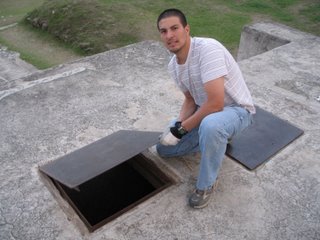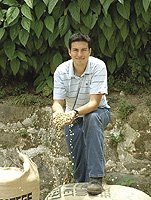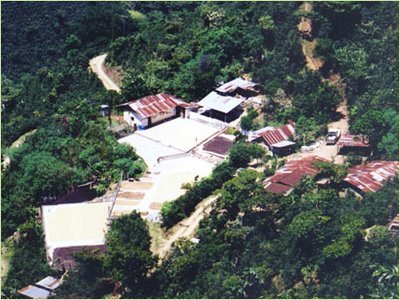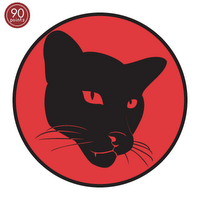the beautiful view

so we're back with the second half of my interview with edwin martinez of finca vista hermosa in huehuetenango, guatemala. rather than bloviate any more, let's get right down to business. enjoy.
********************
8. talk about the role of the coyote in the coffee chain.
In countries like Brazil and Colombia the average grower is middle class or higher and they are a fairly large land owner. The average grower in most other countries is far below middle class and more distant from technology and the market. Thus it takes more middle men to make things happen. Although they often get a bad rap and do tend to abuse their position, their role is vital. More often than not a coyote is someone who owns or has access to a vehicle to move coffee for another who otherwise couldn’t get their product to the next link in the chain.
9. what are some of the earmarks a visitor should notice to determine whether a coffee farm is concerned with quality?
I would first gauge the social climate. How are people treated (be it a co-op or large estate)? Does everyone, particularly those picking coffee, feel they have purpose and ownership? Do they still have their pride and their dignity? Or do you feel like your visiting a sweat shop? Then I might be curious to see if records are kept of all activities. It is important to track history to improve future [production]. It’s not like it’s a daily cycle where you can keep trying again and take risks experimenting. An annual cycle leaves little room for error. One specific thing I look for is if it is a wet milled/washed coffee, is the coffee wet milled the same day it is picked? And how meticulous are they in determining when to cut off fermentation and begin washing?
10. how do you feel about the Fair Trade movement?
Oh boy. You had to ask. I believe historically it has encouraged mediocrity in quality. It is what it is. It guarantees what is average fair wage to qualifying co-ops. Average fair wage is not real attractive in the highlands of Guatemala where there is an exceptionally high cost of production. However, it is a nice insurance for those who are not producing an exceptional coffee that they’ll always get a decent price if the market is not hot. As long as there is a growing consumer market for Fair Trade, this seems to be a fairly sustainable model. The only wrinkle of unsustainability in the system is when the C [commodity coffee futures market tied to the New York Board of Trade] is well above fair trade, than many of FT’s contracts get shorted. I am a big fan of it in these cases where I believe they do successfully meet the goals of their mission statement. They are in fact bringing more of a fair wage to many who otherwise couldn’t make ends meet when the market is low. I remember a few years back people gave Transfair USA a hard time for seeking to improve the lives of so many yet paying a salary of $200k or more to their CEO. I have no problem with this as I know you couldn’t just hire more people with that same amount to accomplish the same thing. Companies this size need qualified CEO’s to be effective. I hope fair trade grows with tremendous success, however there are other models that I feel will accomplish the same, but be based on quality. They just can’t be built up overnight. It will require much collaboration by many over time as well as an increasingly educated consumer base.
11. most of your calendar year is spent in the united states. what are some of the challenges of keeping an eye on quality control during the year and how do you overcome them?
The challenges are absolutely endless. From land and water rights disputes, problems with too much liquor, guerilla warfare in the 80’s, lack of rain, lack of sun, lack of labor, you name it. There are many factors that are controllable and many that aren’t. Some may say the key to quality control is in the details. I would agree, but I believe there is another factor that is much more important.
We have very good people. Our goal is to be sure they are well equipped and happy.
Mitch (as in the hurricane...not a friend) knocked out roads, and Anacafe [Guatemala's coffee oversight organization] feared Guatemala would suffer a greater loss than it did. Not because of Mitch damaging the coffee trees directly, but rather because it eliminated roads. In this case many land owners who live in the city of Huehuetenango were not able to make their regular visits for weeks. They were not able to haul in needed fertilizer and other supplies. We are very well stocked in advance and managed by very forward thinking problem solvers who are respected leaders in their communities. I have to admit there is a sense of concern when someone of our family is not there. But every time there has been a problem--and believe me there have been plenty--it is often handled internally better than it would have been if I or we were there. Last year Carlos goofed up a few thousand pounds of coffee and let it go too long in the tanks. Rather than mixing with the rest, we set this aside. Had he not done this on his own, we would never have known otherwise until it was too late.
12. any cool coffee projects you're working on lately?
I’m always excited about half a dozen projects. I just committed to running a collaborative experiment – which you Aaron are a part of via the study group on [online coffee forum name deleted...you know who you are!], evaluating changes in coffee during the fermentation process. I’ve also been challenged by George Howell [Terroir Coffee] to keep our mirco lots separate... probably so he can pick his favorite. This month we partnered up with Orca Bay Coffee and Toad Mountain Coffee to launch a new venture separate from all of our businesses. We are setting the bar very high for a new retail location that will put a serious dent in coffee education geared towards end consumers in NW Washington.
13. what does a typical day on your farm look like during harvest season? non-harvest season?
For harvest season...this will be a few pages of text… I think you’ll just have to come down and visit and tell this story yourself. Non-harvest time, I will say that every day’s different. Networking and being a resource to our customers sums it up. We’re sold out for life, but there is some natural attrition as well as attrition that I’m pushing for as not all our customers are ideal match. I’d like to have a better relationship with less customers. Monday of this week I’m going down to SEATTLE with Jeff and Rob, our two new business partners for this new “project” mentioned above to visit roasters and retailers to share and mostly learn and brainstorm. My passion is that this new venture is just SCREAMING QUALITY AND SUSTAINABILITY. Tuesday I’m starting to build a deck on our barn and meeting with the health dept and city planning. Wed I drive to eastern Washington to do a TV spot, a few presentations and then pay a visit to some places that are carrying our coffee. Then I’ll spend the weekend with my father in-law as my wife takes her mom, aunt and Grandmother to Vegas for Grandma’s 85th birthday.
14. what do you think the best thing is that could happen to specialty coffee in the next five years?
That someone discovers that coffee is both the cure to cancer and AIDS.
On a serious note, I really don’t know, I’d like to have a smart answer for this, but every day I learn more about coffee and the industry I realize how much I don’t know. But in efforts to give you something, I might say TIME. The 5 years themselves. I think in 5 years we’ll have witnessed many cool things. The specialty industry has evolved in such an accelerated manner the last 5-10 years I can’t imagine what we’ll see in the future. I do dream of a day when I pick up a pound of coffee and I can read stats on the label such as soil type, amount of rainfall, elevation, actual varietal meaning something like “Caturra, Catuai, or Bourbon” in addition to the estate or co-op and region.
15. any final thoughts to share?
A good friend of mine in Bellingham, Washington, has been very helpful to me in shaping where and how we choose to do business. He recently spoke to a gathering of one of the largest accounting firms in British Columbia and based much of his talk on a book titled “Good to Great: Why Some Companies Make the Leap... and Others Don't” by Jim Collins. I haven’t read the book myself, but who needs to read books when you have friends that do? I share this because when I think about the future of the coffee industry I get really excited. I see a growing number of companies and people that are increasingly on the pursuit of excellence! I see more collaboration than ever before, I see guilds forming and forums (and blogs like this one) growing. I see new market developments connecting growers direct to roasters. And I get really excited when I see quality driven folks genuinely striving to make their customers successful. What a novel idea! It truly is an exciting time to be in the coffee industry. I am blessed to be a part of it.
********************
thank you, edwin, for your insightful interview and candor. readers, please give his website a visit at www.fincavistahermosa.com






